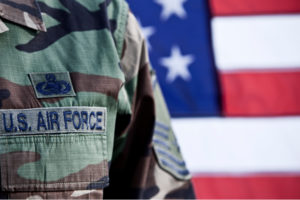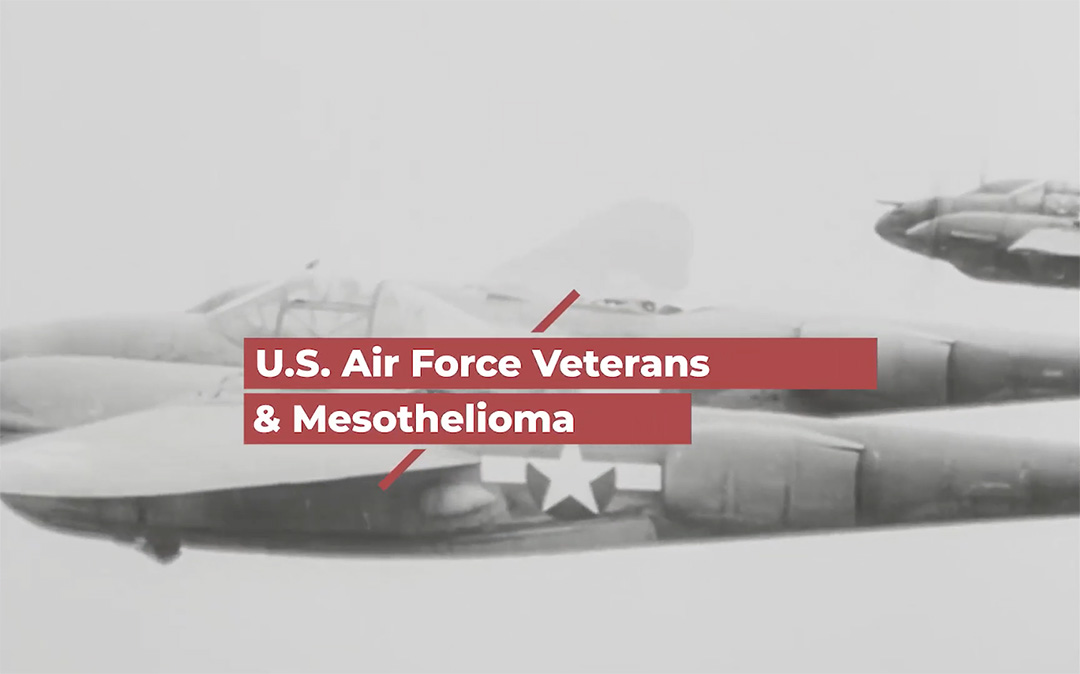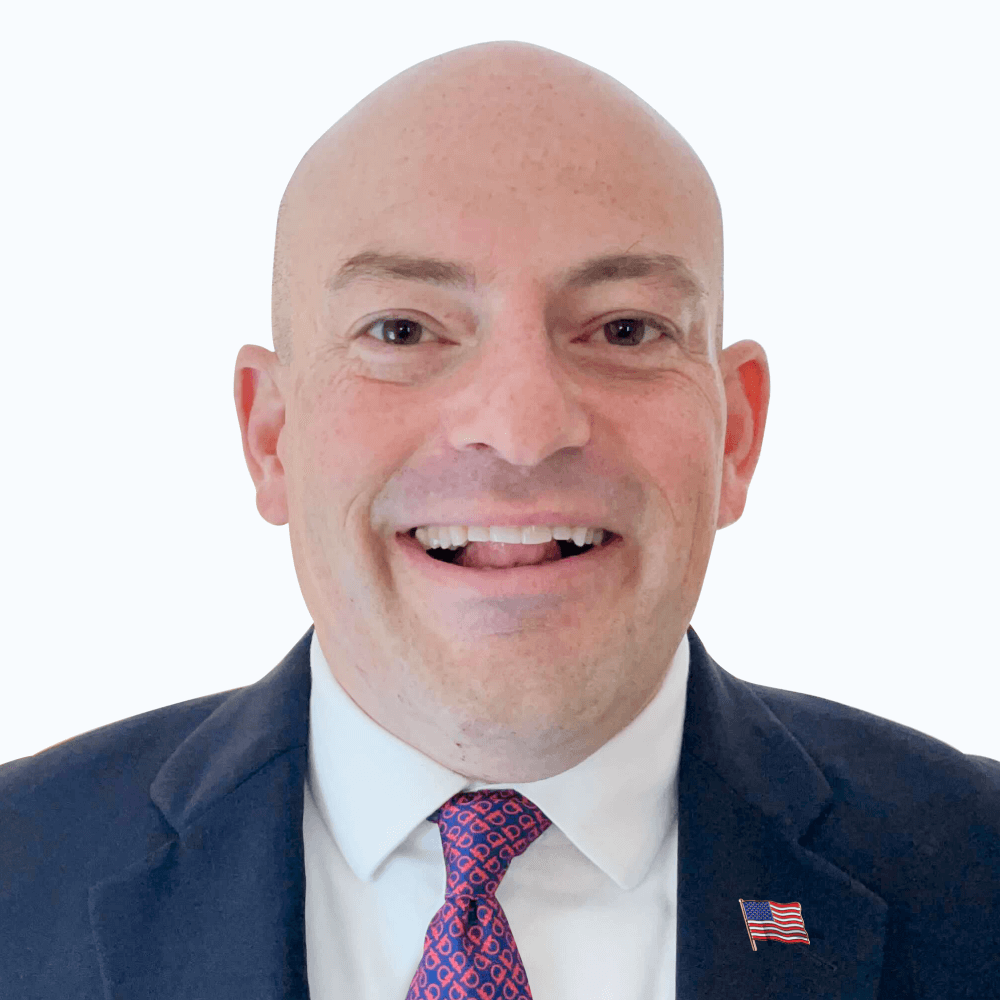Until the early 1980s, the United States Air Force used asbestos for its heat resistance and fireproofing properties. Air Force veterans who worked with asbestos materials have a higher risk of developing mesothelioma. Thankfully, benefits are available for veterans who can prove their mesothelioma began with their time in the Air Force.
Mesothelioma and Air Force Veterans
The U.S. Air Force relied on asbestos between its founding and 1947 and the early 1980s, when the general public learned that the material could cause cancers like mesothelioma.
Members of the Air Force were often exposed to asbestos in:
- Airplanes
- Bases and barracks
- Ground vehicles
The use of asbestos was approved throughout the military before the dangers were well-known. Air Force veterans who worked with asbestos-based products regularly are at the highest risk of mesothelioma and other illnesses today. In fact, U.S. veterans account for one-third of all mesothelioma cases.
Fortunately, the U.S. Department of Veterans Affairs (VA) offers benefits to Air Force veterans with mesothelioma. These benefits include financial compensation to help affected military veterans and their loved ones.
How Were Air Force Veterans Exposed to Asbestos?
Many Air Force veterans were exposed to asbestos while working on planes and bases.
Air Force personnel at the highest risk included:
- Airplane mechanics: Asbestos was used to protect U.S. Air Force planes from fires. Products containing asbestos on planes included brake pads, gaskets, and electrical wiring, putting mechanics at a high risk of exposure.
- Construction workers: Insulation, piping, drywall, and many other construction products contained asbestos, which regularly put workers in danger.
- Other jobs: Air Force electronic technicians, metalsmiths, welders, aircraft handlers, and fire control technicians could have regularly been exposed to asbestos while serving.
Working with asbestos-based products in these roles could send tiny fibers flying into the air, where U.S. Air Force personnel could easily inhale or swallow them.
Video Summary: U.S. Air Force veterans could develop mesothelioma if they were exposed to asbestos during their service. These veterans now qualify for VA benefits and private compensation. View Transcript
For decades, asbestos was considered a miracle material because of its heat resistance and fireproofing properties. The United States Air Force used it extensively in planes and bases between the 1930s and early 1980s for these reasons.
Unfortunately, those who served in the Air Force during this time frame have a higher risk of developing mesothelioma, a rare and aggressive cancer caused by asbestos exposure.
Air Force veterans working with or around asbestos-containing airplane parts could unknowingly inhale or swallow the fibers and get sick later in life.
Many Air Force veterans are diagnosed with mesothelioma every year, even though they were exposed decades ago.
Thankfully, Air Force veterans with mesothelioma can receive benefits from the U.S. Department of Veterans Affairs. Mesothelioma VA benefits include disability compensation, health care, pensions, and more.
U.S. Air Force veterans with mesothelioma may also qualify to file private claims for additional compensation. These types of claims are filed against the makers of asbestos-based products, not the military or government.
We owe a debt of gratitude to our Air Force veterans for their service and sacrifice. If you or a loved one is an Air Force veteran with mesothelioma, contact the Mesothelioma Veterans Center today to get help accessing VA benefits, financial aid, and medical care.
Those at the highest risk of mesothelioma and other asbestos-related diseases worked with asbestos on a daily basis. That said, no level of asbestos exposure is considered safe and anyone exposed can get sick.
Air Force personnel didn’t know that asbestos was dangerous because makers of asbestos-based products hid the risks for decades. By the time the risks came to light in the early 1980s, millions of military service members had been exposed.
Where Were Air Force Veterans Exposed to Asbestos?
Asbestos was widely used by the U.S. Air Force for decades.
Below, learn more about some of the places where asbestos might have been encountered by Air Force personnel.
Air Force Bases
U.S. Air Force bases and barracks were often lined with asbestos-based materials.
In fact, it's believed that over 80 U.S. Air Force bases were built with asbestos, including Edwards Air Force Base, Scott Air Force Base, and Lackland Air Force Base. Most states were home to at least one base that used this dangerous substance.
Asbestos-containing products used on Air Force bases included:
- Ceiling tiles
- Flooring and floor tiles
- Insulation
- Piping
- Roofing materials
- Sheetrock
Asbestos fibers could have easily been released into the air during construction or while repairs were being made on military bases.
Further, asbestos may have been released into the air as these parts wore down.
Exposed to asbestos while serving in the Air Force? Get our Free Veterans Packet — you may qualify for benefits and financial aid.
Planes
The U.S. Air Force used asbestos for a wide variety of functions inside its aircraft. From the military branch’s inception in 1947 until the early 1980s, virtually all of its aircraft contained asbestos.
Aircraft that used asbestos in that time period included:
- U-2 Spyplanes
- SR-71 Blackbird
- KC-135 Stratotanker
- F-104 Starfighter
- B-58 Hustler
- B-36 Peacemaker
- B-47 Stratojet
- B-52 Stratofortress
Asbestos helped protect key components of the aircraft, such as the engine, from excess heat.
Aircraft components that used asbestos included:
- Adhesives
- Brakes and brake pads
- Caulk
- Ceiling tiles
- Electrical wiring
- Engine heat shields
- Exhaust cones
- Gaskets
- Heating systems
- Insulation
- Joint compounds
- Valves
As these components wore down, the risk of asbestos being released into the air increased. Air Force mechanics who installed and repaired these components had the highest risk of asbestos exposure.
Secondhand Exposure Risks and the Air Force
The family members of Airmen could also have been at risk of asbestos exposure if they lived with a service member when the material was widely used.
Air Force service members may have brought asbestos fibers back to their homes. In high-risk jobs, asbestos dust could get stuck to their clothes, hair, and skin. This put their loved ones at risk of exposure, even though they didn't directly work with asbestos themselves.
Thankfully, VA benefits are available to Air Force veterans and their loved ones.
Resources for Air Force Veterans With Mesothelioma
U.S. Air Force veterans fighting mesothelioma can seek VA benefits — including high-quality health care and monthly financial payouts — as well as private resources after a diagnosis.
Learn about some of the top resources below.
Treatment from VA Mesothelioma Specialists
Getting mesothelioma treatment from specialists is key to living longer with this cancer. Mesothelioma is highly aggressive and can be fatal in months without treatment.
Mesothelioma patients who served their country can get care from specialists through VA health care. Some of the world's best mesothelioma doctors treat veterans through the VA health care system.
Further, VA health care often reduces the costs of mesothelioma treatment. Some veterans may even receive health care services for free.
Financial VA Benefits
The VA offers a range of important financial benefits for Air Force veterans diagnosed with mesothelioma, most notably disability compensation.
Mesothelioma is classified with a 100% disability rating by the VA. This means veterans with mesothelioma get the maximum amount of compensation — typically $3,946.25 a month or more for married veterans.
This monthly financial VA benefit can support you and your family if you cannot work or are recovering from treatment.
Work with our VA-accredited lawyers to get help filing for VA benefits, or increasing your disability rating to 100% if you already have benefits and were recently diagnosed with mesothelioma.
Mesothelioma Lawsuits
The makers of asbestos-containing products did not reveal that asbestos was dangerous even though they knew about the risks for decades.
U.S. Air Force veterans can now file private mesothelioma lawsuits against these manufacturers. These claims typically award $1 million on average, with some veterans receiving much more depending on the circumstances.
Further, private claims are never filed against the U.S. military or government, and they don't affect a veteran's ability to file for VA benefits.
Veterans can use money from private claims for anything, including medical bills, household expenses, and more.
Asbestos Trusts Funds
In some cases, makers of asbestos-based products filed for bankruptcy to avoid paying the people they harmed. Private claims cannot be filed against bankrupt asbestos companies.
However, these companies established asbestos trust funds to pay those who were hurt. U.S. Air Force veterans and civilians can file claims with the trusts to get financial compensation.
Today, there is more than $30 billion available in these funds. A top attorney can help you file claims with any trusts you qualify for.
Help for U.S. Air Force Veterans With Mesothelioma
U.S. Air Force veterans can pursue VA benefits, health care services, and private claims to relieve the stresses that come after a mesothelioma diagnosis by working with our team.
The Mesothelioma Veterans Center has helped thousands of other veterans and families get the resources they need following a mesothelioma diagnosis. If eligible, our team will work with you so you can get the benefits you deserve.
We can help U.S. Air Force veterans like you access:
- VA benefits, including monthly payouts and treatments
- Free or low-cost mesothelioma treatments
- Legal payouts often worth $1 million+
Learn about all the ways we may be able to assist you with our Free Veterans Packet.
Mesothelioma & Air Force Veterans FAQs
Can aircraft mechanics receive VA disability compensation?
Possibly, yes. U.S. Air Force veterans that served as aircraft mechanics may qualify for VA disability compensation if they have mesothelioma.
Aircraft mechanics that served in the U.S. Air Force before the early 1980s are at a higher risk of mesothelioma since they likely worked with a lot of asbestos-based aircraft parts, including brake pads and insulation.
Call (877) 450-8973 now to learn if you or a loved one qualifies for VA mesothelioma disability compensation.
Are there private benefits available for U.S. Air Force veterans with mesothelioma?
Yes. Air Force veterans with mesothelioma can seek additional compensation (besides filing a VA claim) through private claims or asbestos trust fund claims.
Private claims typically award $1 million or more for mesothelioma.
Trust fund claims can pay out thousands of dollars (or more) as there's $30 billion available — you might qualify to file claims with multiple trusts and get some of this money.
Our team does not file legal claims or lawsuits against the Air Force, military, or government. Instead, we file claims with the makers of asbestos-containing materials that hid the deadly truth from the military and general public.
When did the Air Force stop using asbestos?
The U.S. Air Force stopped using asbestos in the early 1980s after the dangers became widely known and took steps to renovate planes and bases to remove the toxic substance.
In some cases, sturdy asbestos-based products were left alone as it was unlikely they would release asbestos fibers into the air.
In the 1990s, the Air Force commissioned its Facilities Asbestos Management study on how to deal with leftover asbestos throughout Air Force barracks and aircraft.
This study, completed in 1994, established management principles and practices for dealing with hazardous materials like asbestos across the Air Force.
What military bases had asbestos?
Over 80 U.S. Air Force bases contained asbestos-based products before the risks were known.
Air Force bases with asbestos included:
- Edwards Air Force Base
- Lackland Air Force Base
- Scott Air Force Base
- Wright-Patterson Air Force Base
Many other U.S. military bases were also built with asbestos-containing materials as well, putting anyone who lived or worked on them at risk of mesothelioma later in life.
Those at the highest risk had to work with or around asbestos-containing products on a regular basis.





